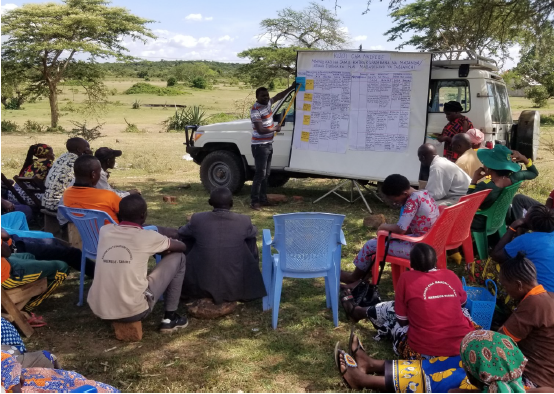For the welfare of animals and farmers
.jpg)
Animal Welfare Action Days at the Farmer Training Centre (December 5th-9th, 2022)
Animals are living beings that can feel and therefore also suffer. Whether pets or farm animals, animals living in the wild or strays, they all deserve to be treated respectfully and in an animal-friendly manner. But what do animals need to be well? And what should be avoided? These and other pertinent questions were the focus of the Animal Welfare Action Days, which SAT held for the first time at the Farmer Training Center in early December 2022. Speakers included two top experts, Andrew Crump, Ph.D., Postdoctoral Research Officer at the London School of Economics and Political Science, working on the Foundations of Animal Sentience project (ASENT), and Dr. Paul Ssuna, MSc in Applied Animal Behavior and Animal Welfare, a veterinarian at Makerere University in Kampala, Uganda, and project manager for the World Animal Protection Society's Veterinarians Worldwide program.
While the first day was spent in the fields with farmers and livestock owners, on the second and third days, some 65 SAT employees, as well as representatives of the organic umbrella organizations Tanzania Organic Agriculture Movement and Kenya Organic Agriculture Network, and journalists listened intently to the speakers' presentations, provided their input in group work, and finally even laid hands on the animals themselves.

SAT is already pursuing numerous practices for the benefit of the animals. But they are not written down anywhere. Not least, for this reason, the last two days were devoted to drafting SAT's animal welfare guidelines and developing a curriculum so that animal welfare can be taught regularly at the FTC in the future. "On the one hand, this is important because animals are particularly close to our hearts," emphasizes Alex Wostry, CEO of Operations SAT. "On the other hand, our goal is to become the first certified organic dairy in East Africa. That is why we are very pleased that representatives of the organic umbrella organizations also took part in the animal welfare action days. Together we will do our utmost to expand the East African organic products standard to include certification of dairy operations."

It should be emphasized that animal welfare is not only an ethical or moral responsibility but even a legal obligation. For example, Tanzania has for many years had one of the best animal welfare laws compared to other African countries, if not considered globally. The problem, however, is that on the one hand, the population lacks the necessary awareness of the needs of animals, and on the other hand, the police, who are responsible for control in this country, are not trained in it.
Fundamentals of animal welfare
The fact is: Animal welfare starts with people. Whether due to ignorance, carelessness, or simply economic constraints - animals suffer due to human misconduct, lack of basic veterinary care, and lack of implementation of existing protection regulations.
SAT has therefore made its business to change this situation and to live active animal welfare. One of the crucial foundations for this is the internationally recognized "Five Freedoms", which the participants at the Animal Welfare Action Days dealt with in detail:
1. Freedom from hunger, thirst, and malnutrition
2. Freedom from discomfort
3. Freedom from fear and suffering
4. Freedom from pain, injury, and disease
5. Freedom to act out normal behaviour
In addition, topics such as animal husbandry, transportation, slaughter, and pain management were addressed. In every respect, the focus should be on preventing or at least minimizing stress, pain, injury, and physical and psychological suffering. In the group work, the practical exercises, and the respective group discussions afterwards, it became clear which areas are already well implemented at SAT, but also where there is a need for improvement. Thus, in the end, it was clear that there was a need for action, especially regarding the awareness and knowledge of farmers and livestock keepers. The participants - especially those who work directly with the farmers - agreed that in the future everything would be done to pass on the knowledge learned during the Animal Welfare Action Days and to push compliance with the new SAT animal welfare guidelines.

To be continued
Another unexpected result, if you will, was that on the fringes of the workshops, the idea was born to set up an independent laboratory for blood and stool analyses - based at the organic dairy. This project, budgeted at around 15,000 euros, should enable livestock farmers to offer high-quality organic milk at fair prices from 2023. "In the context of animal welfare guidelines, the laboratory represents a win-win situation," Alex Wostry is convinced. "If the animals are better off, they give more milk. This, in turn, allows the Maasai to produce more organic milk at better prices."
At any rate, at the end of the week, it was clear: These were not the last animal protection action days. Rather, concrete plans have already been made for three-day workshops that will start in 2023. After all, animal welfare benefits not only the animals but each one of us. With this in mind, here's to a world in which humans and animals live in harmony with each other and in which animals are treated with respect and in a manner appropriate to their species.
The workshop is kindly supported by the Biovision Foundation







